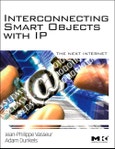Interconnecting Smart Objects with IP: The Next Internet explains why the Internet Protocol (IP) has become the protocol of choice for smart object networks. IP has successfully demonstrated the ability to interconnect billions of digital systems on the global Internet and in private IP networks. Once smart objects can be easily interconnected, a whole new class of smart object systems can begin to evolve. The book discusses how IP-based smart object networks are being designed and deployed.
The book is organized into three parts. Part 1 demonstrates why the IP architecture is well suited to smart object networks, in contrast to non-IP based sensor network or other proprietary systems that interconnect to IP networks (e.g. the public Internet of private IP networks) via hard-to-manage and expensive multi-protocol translation gateways that scale poorly. Part 2 examines protocols and algorithms, including smart objects and the low power link layers technologies used in these networks. Part 3 describes the following smart object network applications: smart grid, industrial automation, smart cities and urban networks, home automation, building automation, structural health monitoring, and container tracking.
Please Note: This is an On Demand product, delivery may take up to 11 working days after payment has been received.
Table of Contents
Part I: The Architecture Chapter 1: What are Smart objects? Chapter 2: The IP protocol architecture Chapter 3: Why IP for smart objects? Chapter 4: IPv6 for Smart Object Networks and The Internet of Things Chapter 5: Routing Chapter 6: Transport Protocols Chapter 7: Service Discovery Chapter 8: Security for Smart Objects Chapter 9: Web services For Smart Objects Chapter 10: Connectivity models for smart object networksPart II: The Technology Chapter 11: What is a Smart Object? Chapter 12: Low power link layer for smart objects networks Chapter 13: uIP A Lightweight IP Stack Chapter 14: Standardization Chapter 15: IPv6 for Smart Object Networks A Technology Refresher Chapter 16: The 6LoWPAN Adaptation Layer Chapter 17: RPL Routing in Smart Object Networks Chapter 18: The IPSO Alliance Chapter 19: Non IP Technology
Part III: The Applications Chapter 20: Smart Grid Chapter 21: Industrial Automation Chapter 22: Smart Cities and Urban Networks Chapter 23: Home Automation Chapter 24: Building Automation Chapter 25: Structural Health Monitoring Chapter 26: Container Tracking








